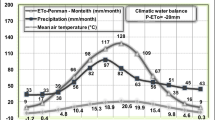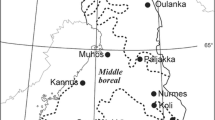Abstract
In the current context of global warming, an analysis is required of spatially-extensive and long-term blooming data in fruit trees to make up for insufficient information on regional-scale blooming changes and determinisms that are key to the phenological adaptation of these species. We therefore analysed blooming dates over long periods at climate-contrasted sites in Western Europe, focusing mainly on the Golden Delicious apple that is grown worldwide. On average, blooming advances were more pronounced in northern continental (10 days) than in western oceanic (6–7 days) regions, while the shortest advance was found on the Mediterranean coastline. Temporal trends toward blooming phase shortenings were also observed in continental regions. These regional differences in temporal variability across Western Europe resulted in a decrease in spatial variability, i.e. shorter time intervals between blooming dates in contrasted regions (8–10-day decrease for full bloom between Mediterranean and continental regions). Fitted sequential models were used to reproduce phenological changes. Marked trends toward shorter simulated durations of forcing period (bud growth from dormancy release to blooming) and high positive correlations between these durations and observed blooming dates support the notion that blooming advances and shortenings are mainly due to faster satisfaction of the heating requirement. However, trends toward later dormancy releases were also noted in oceanic and Mediterranean regions. This could tend toward blooming delays and explain the shorter advances in these regions despite similar or greater warming. The regional differences in simulated chilling and forcing periods were consistent with the regional differences in temperature increases.







Similar content being viewed by others
References
Aono Y, Moriya C (2003) A generalized model to estimate flowering for cherry tree (Prunus yeodensis) considering both processes of endodormancy completion and development. J Agric Meteorol 59:165–177
Atkinson CJ, Taylor L (1994) The influence of autumn temperature on flowering time and cropping of Pyrus communis cv. Conference. J Hortic Sci 69:1067–1075
Bidabé B (1967) Action de la température sur l’évolution des bourgeons de pommier et comparaison de méthodes de contrôle de l’époque de floraison. Ann Physiol Vég 9:65–86
Cannell MGR, Smith RI (1986) Climatic warming, spring budburst and frost damage on trees. J Appl Ecol 23:177–191
Celton JM, Martinez S, Jammes MJ, Bechti A, Salvi S, Legave JM, Costes E (2011) Deciphering the genetic determinism of bud phenology in apple progenies: a new insigtht into chilling and heat requirement effects on flowering dates and positional candidate genes. New Phytologist 192:378–392
Chmielewski FM, Rötzer T (2001) Response of tree phenology to climate change across Europe. Agric For Meterol 108:101–112
Chmielewski FM, Müller A, Bruns E (2004) Climate changes and trends in phenology of fruit trees and field crops in Germany, 1961–2000. Agric For Meterol 121:69–78
Chuine I (2000) A unified model for budburst of trees. J Theor Biol 207:337–347
Chuine I, Cour P, Rousseau DD (1998) Fitting models predicting dates of flowering of temperate-zone trees using simulated annealing. Plant Cell Environ 21:455–466
Darbyshire R, Webb L, Goodwin I, Barlow S (2011) Winter chilling trends for deciduous trees in Australia. Agric For Meterol 151:1074–1085
De Melo-Abreu JP, Barranco D, Cordeiro AM, Tous J, Rogado BM, Villalobos FJ (2004) Modelling olive flowering date using chilling for dormancy release and thermal time. Agric For Meterol 125:117–127
Eccel E, Rea R, Caffarra A, Crisci A (2009) Risk of spring frost to apple production under future climate scenarios: the role of phenological adaptation. Int J Biometeorol 53:273–286
Farajzadeh M, Rahimi M, Kamali GA, Mavrommatis T (2010) Modelling apple tree bud burst time and frost risk in Iran. Meteorol Appl 17:45–52
Fitter AH, Fitter RSR (2002) Rapid changes in flowering time in British plants. Science 296:1689–1691
Fuchigami LH, Nee CC (1987) Degree growth stage model and rest-kreaking mechanisms in temperate woody perennials. HortSci 22:836–842
Fujisawa M, Kobayashi K (2010) Apple (Malus pumila var. domestica) phenology is advancing due to rising air temperature in northern Japan. Glob Chang Biol 16:2651–2660
Garcia-Mozo H, Orlandi F, Galan C, Fornaciari M, Romano B, Ruiz L, Diaz de la Guardia C, Trigo MM, Chuine I (2009) Olive flowering phenology variation between different cultivars in Spain and Italy: modelling analysis. Theor Appl Climatol 95:385–395
Grab S, Craparo A (2011) Advance of apple and pear tree full bloom in response to climate change in the southwestern Cape, South Africa: 1973–2009. Agric For Meterol 151:406–413
Guédon Y, Legave JM (2008) Analyzing the time-course variation of apple and pear tree dates of flowering stages in the global warming context. Ecol Model 219:189–199
Hauagge R, Cummins JN (1991) Phenotypic variation of length of bud dormancy in apple cultivars and related Malus species. J Am Soc Hortic Sci 116:100–106
Legave JM, Farrera I, Alméras T, Calleja M (2008) Selecting models of apple flowering time and understanding how global warming has had an impact on this trait. J Hortic Sci Biotechnol 83:76–84
Lopez G, Dejong TM (2007) Spring temperatures have a major effect on early stages of peach fruit growth. J Hortic Sci Biotechnol 82:507–512
Meier U (1997) BBCH-Monograph. Growth Stages of Plants- Entwicklungsstadien von Pflanzen - Estadios de las plantas - Développement des Plantes. Berlin and Wien: Blackwell Wissenschaftsverlag
Menzel A, Sparks T (2006) Temperature and plant development: phenology and seasonality. In: Morison JIL, Morecroft MD (eds) Plant growth and climate change. Blackwell Publishing Ltd, pp 70–95
Menzel A, Sparks T, Estrella N, Roy DB (2006) Altered geographic and temporal variability in phenology in response to climate change. Glob Ecol Biogeogr 15:498–504
Miller-Rushing AJ, Katsuki T, Primack RB, Ishii Y, Don Lee S, Higuchi H (2007) Impact of global warming on a group of related species and their hybrids: cherry tree (Rosaceae) flowering at Mt Takao, Japan. Am J Bot 94:1470–1478
Naor A, Flaishman M, Stern R, Moshe A, Erez A (2003) Temperature effects on dormancy completion of vegetative buds in apple. J Am Soc Hortic Sci 128:636–641
Nordli O, Wielgolaski FE, Bakken AK, Hjeltnes SH, Mage F, Sivle A, Skre O (2008) Regional trends for bud burst and flowering of woody plants in Norway as related to climate change. Int J Biometeorol 52:625–639
Primack RB, Ibanez I, Higuchi H, Don Lee S, Miller-Rushing AJ, Wilson AM, Silander JA Jr (2009) Spatial and interspecific variability in phenological responses to warming temperatures. Biol Conserv 142:2569–2577
Rea R, Eccel E (2006) Phenological models for blooming of apple in a mountainous region. Int J Biometeorol 51:1–16
Richardson EA, Seeley SD, Walker DR (1974) A model for estimating the completion of rest for ‘Redhaven’ and ‘Elberta’ peach trees. Hort Sci 9:331–332
Spiegel-Roy P, Alston FH (1979) Chilling and post-dormant heat requirements as selection criteria for late-flowering pears. J Hortic Sci 54:115–120
Sunley RJ, Atkinson CJ, Jones HG (2006) Chill unit models and recent changes in the occurrence of winter chill and spring frost in the United Kingdom. J Hortic Sci Biotechnol 81:949–958
Vitasse Y, François C, Delpierre N, Dufrêne E, Kremer A, Chuine I, Delzon S (2011) Assessing the effects of climate change on the phenology of European temperate trees. Agric For Meteorol. doi:10.106/j.agrformet.2011.03.003
Acknowledgements
The authors wish to extend their thanks to INRA in Angers and Marco Fontanari in Trento for collecting the blooming dates. We also wish to thank the San Michele Foundation for the temperature collect in Trento.
Author information
Authors and Affiliations
Corresponding author
Rights and permissions
About this article
Cite this article
Legave, J.M., Blanke, M., Christen, D. et al. A comprehensive overview of the spatial and temporal variability of apple bud dormancy release and blooming phenology in Western Europe. Int J Biometeorol 57, 317–331 (2013). https://doi.org/10.1007/s00484-012-0551-9
Received:
Revised:
Accepted:
Published:
Issue Date:
DOI: https://doi.org/10.1007/s00484-012-0551-9




